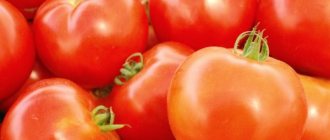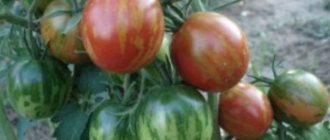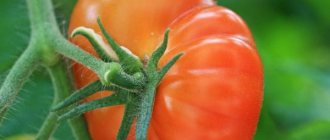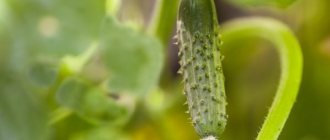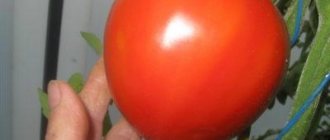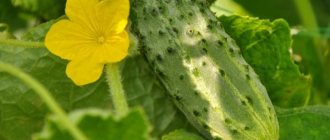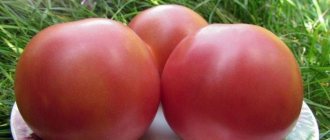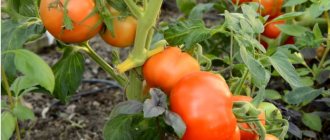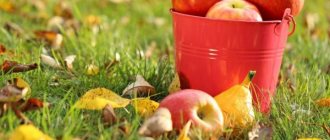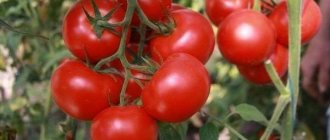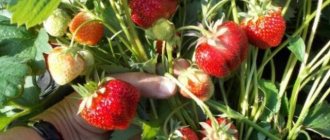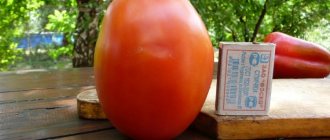Vegetable growing » Tomatoes
0
1771
Article rating
Kira Stoletova
The tomato is a red vegetable beloved by adults and children in many countries. Among its varieties there are sweet and sour, red, pink and green fruits. From the point of view of cultivation, they are divided according to such characteristics as more and less immune-resistant, with high and low yields, etc. The De Barao variety has several subtypes that differ in appearance and growth characteristics. In most cases, they are named according to the color of the pulp and skin. The most famous variety is De Barao Red. Tomato De Barao Tsarsky is a variety popular among farmers in our country, originally from Brazil, Ecuador and Peru, which became widespread in Russia in the 90s of the last century: in 1998 it was officially registered as a greenhouse variety, although it was brought to the empire back in the 1600s years. What is the secret of his success?
Characteristics of tomato De Barao Tsarsky
Description of the variety
“De Barao Tsarskiy” is a mid-season variety. Technical maturity occurs 120-125 days after sowing the seeds. Bush of indeterminate type - with an unlimited growth point. The length of the stem can reach 1.5-2.0 meters. The type of inflorescence is carpal. Each bush produces about 8-10 fruit clusters, each containing 7-8 fruits.
Fruit
Tomatoes have a characteristic shape with a pronounced nose. Mature skin has a pink-red color. The average weight of one tomato is from 100 to 150 grams.
Other fruit features:
- Low dry matter content – within 4-5%;
- Presence of 2 seed chambers;
- Fleshy juicy pulp.
Tomato de Barao black. Characteristics of the variety and cultivation characteristics
The variety was included in the State Register in 1999. Seeds are produced and sold by most well-known agricultural companies, “Gavrish”, “Aelita” and many others). Tomato can be grown in all regions of the country in open ground and summer shelters.
Packages with seeds of varieties from various manufacturers
Plants develop according to the indeterminate type. The bushes are tall; in a greenhouse they grow up to 200 cm or more. The stems are strong, but can break under the load of ripe fruits. Therefore, it is recommended to tie them to a support. The variety has increased resistance to major tomato diseases, including late blight.
“De Barao black” is a late ripening tomato (120-130 days from the appearance of full shoots). In regions with difficult weather conditions, it is better to grow the variety in greenhouses. The fruits are smooth, weighing from 50 to 60 g, ovoid, dark brown in color with a purple tint. The pulp is dense and has a very pleasant taste. The skin is durable and not prone to cracking. With proper agricultural technology, up to 8 kg of tomatoes can be harvested per square meter of planting per season.
Like most late-ripening varieties, the variety requires early sowing. In the middle zone, it is recommended to do this around mid-February. Seedlings are planted in a permanent place at the age of 70-75 days. No more than 4 plants are placed per square meter. The bushes are formed into 1-2 trunks, pinching them after 5-7 flower clusters appear. The variety is resistant to temperature fluctuations, but requires regular watering and fertilizing.
Like most late-ripening varieties, the variety requires early sowing. In the middle zone, it is recommended to do this around mid-February
Among the undoubted advantages of the variety it should be noted:
- unpretentiousness and absence of problems with cultivation;
- disease resistance;
- productivity;
- good taste;
- transportability and keeping quality of fruits;
- suitability of tomatoes for whole-fruit canning.
The variety can be recommended to those summer residents who do not yet have solid experience in growing tomatoes. According to reviews, the “De Barao black” tomato is a plant that can withstand the vagaries of the weather well, and in protected soil, subject to additional treatments against diseases, it can bear fruit until the end of September, which increases the likelihood of obtaining a rich harvest.
Tomatoes: advantages and disadvantages
“De Barao Tsarsky” has a number of advantages:
- Good yield;
- Presentable appearance of the bush and excellent marketability of the fruit;
- Ripens at room conditions;
- Has strong immunity;
- Universal application;
The variety also has its drawbacks.:
- Due to its high growth, it requires pinching and installation of strong supports;
- The bush is quite spreading, so it takes up a lot of space.
Agrotechnical features
There are several general recommendations and features that apply to any subspecies of de Barao. This variety is indeterminate, that is, the stem grows all the time and can reach 4 meters. This means that we ourselves must control the growth and pinch the top when we need it.
You also need to take into account that this variety requires more space around it, and determinate tomatoes do not coexist well with it; de Barao will dominate. But a high harvest will more than pay for these “losses”.
This variety is mainly suitable for southern latitudes when it comes to planting in open ground, and in more northern areas it is successfully grown in greenhouses.
Growing and planting seedlings
Seeds for seedlings are usually sown in February, after the 15th
You can sow in boxes, in pots, in cups, whoever comes up with something, but it is important that the height of the soil is at least 12 cm, and the distance between rows is at least 5 cm
We plant at a depth of 7-8 cm. The seeds must be prepared in advance. To do this, soak them for two hours in a soda solution (1 teaspoon per 1 liter). Unsuitable seed material will float, the remaining seeds need to be dried and can be planted (Figure 10).
The boxes need to be covered with film until the tomatoes sprout. And, of course, you will have to tinker with hardening off the seedlings. Some take it out to a cooler room at night, and some open the window for a while, gradually increasing the hardening time. The optimal temperature for seedlings is +20-24°C, and for hardening - not lower than +12°C.
Figure 10. The crop is grown only by seedlings
You can plant seedlings in open ground in the second half of May. Some people rush to plant earlier, but then frosts become even more dangerous for tomatoes. If, after all, we know about the upcoming frosts, then it is better to wrap our tomatoes somehow. You can, for example, close it with plastic bottles with a cut bottom. Such “caps” can be made once every few years. If you plant seedlings in a greenhouse, then the issue of frost disappears.
So. We dig a hole 15-20 cm deep and “lay” our plant, having first torn off all the leaves except the top ones. Water it with warm water or a weak solution of copper sulfate (this is a good prevention against late blight) and bury it with loose soil, pressing a little. You can’t bury the entire 20 cm, so you will have a small hole where water will collect, which will make watering easier later. We immediately install stakes up to 3 meters in height. Why right away? Because this way you definitely don’t injure the root, even by accident. You need to leave about 1.5 meters between plants; the indeterminate loves space.
Watering and fertilizing
Although tomatoes love moisture, it is important to choose the right watering schedule. Better infrequently, but a lot
About once every four days, and use a bucket of water per square meter. The volume of water should be reduced when the tomatoes have already appeared, so that they do not become tasteless and watery. Of course, the local climate will be decisive in the watering schedule (Figure 11).
Figure 11. Watering is usually combined with fertilizing
Two feedings can be done: one a week after planting the seedlings with organic matter, and the second in early July. During the second feeding, you can add potassium sulfate (20 grams per bucket of water) and microfertilizers (2 tablets per bucket of water) to the organic matter. Water at the rate of 1 liter per plant.
Disease and pest control measures
Although de Barao is resistant to tomato diseases, such as late blight, he still needs certain prevention or treatment (if it happens) (Figure 12).
Figure 12. Plants are sprayed when the first symptoms are detected to save the crop
It happens that de Barao suffers from bacterial black spot. Then it needs to be treated with Fitolavin. Blossom rot is also dangerous. Both diseases are associated with excess moisture. For prevention, you can spray with calcium nitrate or copper sulfate solution a couple of times a season.
It is also important to remember the special time after stepsoning. During this period, it is better to refrain from watering, because tomatoes can become infected with diseases through “wounds” from stepchildren.
If a Colorado potato beetle or slug appears, you need to do the appropriate treatment. You can find more information about de Barao tomatoes and the features of their cultivation in the video.
Application of fruits
REFERENCE : In the food industry, “De Barao Tsarsky” is used for the production of baby food and tomato paste.
Due to the suitable size of the fruit and the ability to withstand heat treatment without loss of commercial qualities, “De Barao Tsarsky” is most often used for whole-fruit canning (one of the popular names of this variety is even associated with this - “Zakatochnaya Budenovka”). However, “De Barao” allows you to successfully solve other culinary problems:
- Cutting into salads or eating fresh;
- Processing into juice or fruit drink;
- Cooking borscht and other hot dishes;
- Barrel salting;
- Dry in the sun or in the oven.
Growing tomatoes
In most regions, the variety is grown through seedlings and planted in a greenhouse. Although in the southern regions with a long summer season, planting in open ground is also successfully practiced. "De Barao" is an unpretentious plant that successfully withstands temperature changes, lack of sunlight and flaws in agricultural technology.
How to prepare seeds?
“De Barao Tsarskiy” is a varietal tomato that produces excellent seedlings in the second and subsequent generations. However, self-collected seeds (as well as those purchased in a special store) require complete pre-sowing treatment. It consists of the following stages :
- Seed sorting (for self-collected ones). It is necessary to discard empty and damaged seeds, as well as seeds with traces of mold.
- Disinfection. The seeds are collected in gauze and dipped in a solution of potassium permanganate or hydrogen peroxide for 15-20 minutes.
- Growth stimulation. The seed material is soaked in solutions of the preparations “Effekton”, “Kornevin”, “Epin-Extra” for 6-12 hours.
- Bubble warm water with oxygen (for example, using an aquarium pump) for 24 hours before planting.
REFERENCE : Pre-sowing treatment increases germination by 50% and yield by 20-30%.
Sowing seed material
The soil for sowing should be loose, but contain a sufficient amount of nutrients. To 2 parts of turf add 2 parts of peat, 1 part of sand and 0.5 parts of vermicompost. If possible, it is advisable to add a little perlite and vermiculite.
A wooden box with a side of 7 cm is used as a container. The seeds are planted 2 cm into the ground using the square-cluster method with an interval of 2 cm. After watering with warm water, the box is covered with film or glass and left until germination.
After pipping the sprouts, the film is removed and cultivation continues in a room that meets the criteria:
- Air temperature – 20-24*C;
- Lighting – 12-16 hours a day (if necessary, LED lamps can be installed).
Seedlings must be periodically watered with warm water and fed with complex preparations every 20 days. The picking is carried out after the deployment of the 3rd true leaf.
Rules for planting seedlings
Planting in a permanent place is carried out 50-60 days after sowing, but not earlier than the 3rd decade of April.
Recommended landing pattern:
- Row spacing – 70 cm;
- The distance between bushes is 70 cm;
- Maximum planting density – 2 plants per 1 sq.m.
The plant is transferred to a planting hole with a large lump of earth so as not to damage the root structure. A handful of humus, peat and a tablespoon of ash are placed under each seedling.
IMPORTANT : Before transplanting plants, you need to take care of the garter system: make trellises or drive pegs into the holes so as not to do this later, exposing the tomatoes to additional stress.
Diseases and pests
The presented culture is quite resistant to various diseases, including late blight. Only if agricultural practices are violated, the following diseases can affect it:
- Blackleg. To prevent it from damaging your seedlings, it is recommended to sprinkle the soil on which the seeds are sown with wood ash.
- Mosaic . This disease can be easily identified by the appearance of green and red spots on the fruit. To avoid its appearance, the bushes need to be treated with a mixture of water and milk in proportions of 10:1. If the disease has already infected the bush, it will have to be dug up and the ridge itself treated with copper sulfate.
- Fomoz . With this disease, a brown spot forms near the stalk. If such a problem occurs, the crop should be treated with Zaslon.
- Brown rot. Leads to withering and death of the bush. With it, the crop is also treated with a “barrier”.
If we talk about pests, most often tomatoes of this variety suffer from mole crickets, spider mites and Colorado potato beetles. To get rid of them, the bushes need to be treated with drugs like “Grom”, “Karbofos”, “Prestige”.
Read about diseases of cucumbers in greenhouses and their treatment in this material.
Read information about mites on cucumbers here.
To protect your bushes from diseases and pests, it is recommended to plant them as far as possible from tomatoes and other similar crops. This is especially important for those gardeners who work with tomatoes in the open ground.
Bush care
The most important thing in caring for “De Barao Tsarsky” is timely pinching and gartering. Plants begin to be pruned on the 10th day after planting. All stepsons, except 1-2 main stems, must be removed. In the later phases of the growing season, it is also recommended to remove leaves below the 1st cluster. The garter system must be reliable, capable of withstanding significant wind loads arising from the high foliage of plants.
The rest of the care rules are standard:
- Regular watering once every 3 days in dry weather, and once every 5-6 days in normal weather. Watering should be balanced: extending 30 cm into the ground, but so that the water does not linger in the garden bed. It is advisable to water after sunset, avoiding moisture on the leaves and stems.
- Mulching the beds with a 20 cm layer of straw. It is especially important during droughts, because it allows you to retain a significant proportion of moisture in the soil.
- Fertilizing with alternating mineral and organic fertilizers. You need to feed every 14 days.
De Barao giant yellow.
The time is getting closer when you need to sow tomatoes for seedlings, so now is the time to start choosing and purchasing seeds. At first glance, this is very simple: even inexperienced gardeners can read reviews about tomato varieties in various sources. But in fact, every year it becomes more and more difficult to choose the right variety of tomatoes. Sellers, in order to attract buyers, are trying to expand their range, and to navigate it we need to have a guidebook so that the chosen variety meets our expectations. But there is one variety that is known to all gardeners - De Barao giant tomatoes. Their description, as well as the features of agricultural technology, are presented in this article.
Description
The De Barao giant tomato variety is characterized by powerful, tall plants. They are undemanding in care, and are also resistant to various types of diseases. The distinctive qualities of the De Barao giant include its cold resistance and shade tolerance.
This variety is considered one of the most popular for growing in greenhouses. It is a late-ripening variety that is recommended to be grown in open protected ground. From full sunrise to the beginning of ripening, 125 days pass. The plant is classified as indeterminate; its height can reach more than 2 meters. The fruits, whose weight is 70-190 g, look like a plum. They are dense, red in color and have a green spot in the place where the peduncle is adjacent. Late blight is practically not dangerous for the plant. Productivity is 5.5-6.4 kg/m². Both fresh and canned fruits have excellent taste.
Advantages
According to reviews from experienced gardeners, De Barao giant tomatoes do not have many advantages, but they are significant. These include:
- high productivity;
- the fruits are suitable for whole-fruit canning;
- wonderful taste.
Features of cultivation
There is nothing complicated about growing De Barao giant tomatoes. For seedlings, seeds must be sown in boxes in early March. To prepare a nutrient substrate, you need to take the same amount of garden soil and leaf humus or manure; it should be crumbly. To the resulting mixture you need to add 15 g of potassium chloride and the same amount of urea, 50 g of superphosphate and 1 glass of ash. After this, mix the mixture thoroughly and pour it into the boxes. Then the seeds are sown, and also sprinkled with the same composition. The layer of the mixture should be 5-6 mm. You need to water the seeds with a weak solution of potassium permanganate. The solution must be warmed before use. To avoid washing out the seeds, it is better to use a teaspoon for watering. After this, the boxes are covered with plastic film. This is necessary to ensure that the desired temperature and importance are maintained. Now the boxes with seeds are placed on the windowsill. Within a week, the first shoots appear, which must be watered once every two days.
After the seedlings have two leaves, the seedlings are picked. Diving can be done in paper or plastic cups. But before this, the plants in the boxes are well watered. You need to take out the seedlings with soil on the roots, this reduces the likelihood of damage to the weak root system, and the tomatoes will be able to more easily take root in a new place.
Tall seedlings are fed every 10 days. As soon as the days become warm, the seedlings can be moved outside to harden off. But you need to be very careful and make sure that the seedlings do not remain in the fresh air during the sun. Tomatoes begin to be planted in the ground at the end of April. Initially, seedlings are planted in a greenhouse to protect them from night cold. The greenhouse must be opened during the day and closed at night. Only in the second half of May are tomatoes planted in open ground. During planting, each hole should be watered, but it is extremely important that the water does not wash away the plant.
De Barao giant tomatoes need to be planted all summer. And the flowering of this plant will be observed even in the first days of autumn. And if it is warm, then the tomatoes will bear fruit until October.
The video shows a tall tomato bush of the De Barao giant variety; you can see the yield level from the bush.
